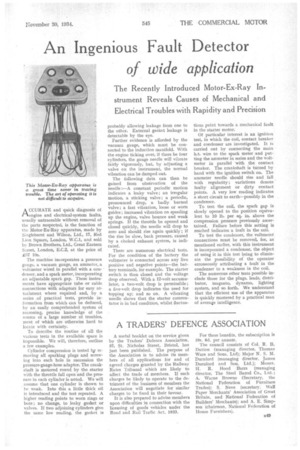An Ingenious Fault Detector of wide application
Page 67

If you've noticed an error in this article please click here to report it so we can fix it.
ACCURATE and quick diagnosis of engine and electrical-system faults, usually untraceable without removal of the parts suspected, is the function of the Motor-Ex-Ray apparatus, made by Singlehurst and Wilson, Ltd., 17, Red Lion Square, London, W.C.1, and sold by Brown Brothers, Ltd., Great Eastern Street, London, E.C.2, at the price of £37 10s.
The machine incorporates a pressure gauge, a vacuum gauge, an ammeter, a voltmeter wired in parallel with a condenser, and a spark meter, incorporating an adjustable spark gap. These instruments have appropriate tube or cable connections with adaptors for easy attachment where required and, by a series of practical tests, provide information from which can be deduced, by an easily comprehended system of reasoning, precise knowledge of the source of a large number of troubles, most of which are otherwise hard to locate with certainty.
To describe the routine of all the various tests in the available space is impossible. We will, therefore, outline a few examples.
Cylinder compression is tested by removing all sparking plugs and screwing into each hole in succession the pressure-gauge-hose adaptor. The crankshaft is motored round by the starter with the throttle full open and the pressure in each cylinder is noted. We will assume that one cylinder is shown to be weak. Into this a little thick oil is introduced and the test repeated. A higher reading points to worn rings or bore; no change, to leaky gasket or valves. If two adjoining cylinders give the same low reading, the gasket is probably allowing leakage from one to the other. External gasket leakage is detectable by the eye.
Further evidence is afforded by the vacuum gauge, which must be connected to the induction manifold, With the engine ticking over, if there be four cylinders, the gauge needle will vibrate fairly vigorously, but, by adjusting a valve on the instrument, the normal vibration can be damped out.
The following data can then be gained from observation of the needle :—A constant periodic motion indicates a leaky valve ; an irregular motion, a sticking valve ; a periodic, pronounced drop, a badly burned valve ; a fast vibration, loose or worn guides ; increased vibration on speeding up the engine, valve bounce and weak springs. If the throttle be opened and closed quickly, the needle will drop to zero and should rise again quickly ; if the rise be slow, back pressure, caused by a choked exhaust system, is indicated.
There are numerous electrical tests. For the condition of the battery the voltmeter is connected across any live positive and negative points—the battery terminals, for example. The starter switch is then closed and the voltage drop observed. With a 12-volt accumulator, a two-volt drop is permissible ; a five-volt drop indicates, the need for topping up; and so on. A vibrating needle shows that the starter commutator is in bad condition, whilst fluctua
tions point towards a mechanical fault in the starter motor.
Of particular interest is an ignition test, in which the coil, contact breaker and condenser are investigated. It is carried out by connecting the main h.t. wire to the spark meter and putting the ammeter in series and the voltmeter in parallel with the contact breaker. The crankshaft is turned by hand with the ignition switch on. The ammeter needle should rise and fall with regularity ; variations denote faulty alignment or dirty contact points. A very low reading indicates a short circuit to earth—possibly in the condenser.
To test the coil, the spark gap is slowly opened to the position equivalent to 10 lb. per sq. in. above the compression pressure previously ascertained. Failure before this setting is reached indicates a fault in the coil.
To test the condenser, the voltmeter connections must be removed, for, as mentioned earlier, with this instrument is incorporated a condenser, the object of using it in this test being to eliminate the possibility of the operator erroneously attributing a fault in the condenser to a weakness in the coil.
The numerous other tests possible include those for the plugs, leads, distributor, magneto, dynamo, lighting system, and so forth. We understand that the efficient use of the apparatus is quickly mastered by a practical man of average intelligence.




































































































